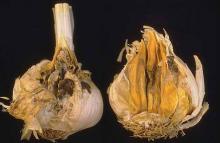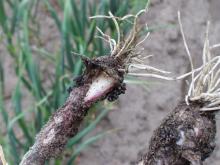Cause Botrytis porri and B. aclada (formerly B. alliiaclada), fungi. Both fungi are found in western Oregon but only B. porri is found on garlic east of the Cascade Range. These pathogens survive the winter on dead plant parts in soil, as sclerotia, and on infected bulbs. Infection occurs through neck tissue or through wounds in bulbs. Severe losses are most commonly from excessive irrigation and/or rain. Other factors such as excessive nitrogen, inadequate or improper curing, and improper storage have not been investigated.
Symptoms The disease usually appears first on necks near the soil line at any time after spring greenup when weather conditions permit. The disease becomes worse when it starts early in the season. Extensive development of sclerotia is best seen on maturing bulbs just before and during harvest. The fungus moves rapidly into the succulent garlic bulb's neck region, producing a water-soaked appearance. A gray mold develops on the surface of or between garlic scales, later producing black bodies (sclerotia), which develop around the neck. Before bulbing, plants may die or recover if weather permits. Bulbs infected late break down to a soft mass, and secondary infections by other organisms follow.
Cultural control Difficult to control in extended wet weather.
- Allow the tops to mature well, then lift or undercut the garlic.
- If normal dry weather prevails, cure garlic on the ground for 6 to 10 days.
- When topping, keep bruising and mechanical injury to a minimum.
- Store garlic in well-ventilated houses at temperatures of 32°F, or just slightly higher.
- Avoid frequent and excessive irrigation.
- Visual inspection of seed garlic with a hand lens may help. Examine the basal plate or bottom of garlic for gray mold.
Chemical control Treat seed (cloves) to reduced incidence of fungi in the seed. Foliar sprays may prove effective as well.
- Cueva (Group M1) at 0.5 to 2 gal/100 gal water on 7- to 10-day intervals. Poor control as a stand-alone product. May be applied on the day of harvest. 4-hr reentry. O
- Fontelis (Group 7) at 16 to 24 fl oz/A on 7- to 14-day intervals. Preharvest interval is 3 days. 12-hr reentry.
- Inspire Super (Group 3 + 9) at 16 to 20 fl oz/A prior to disease onset on 7- to 10-day intervals. Do not use more than two (2) sequential treatments. Preharvest interval is 7 days for bulb onions; 14 days for green onions. 12-hr reentry.
- OSO 5% SC (Group 19) at 3.75 to 13 fl oz/A on 7- to 14-day intervals. Can be applied the day of harvest. 4-hr reentry. O
- Scala SC (Group 9) at 9 or 18 fl oz/A on 7- to 14-day intervals for great-headed garlic. When applying alone, do not make more than two (2) consecutive applications of Scala SC without alternating to an equal number of applications of a fungicide from a different resistance management group. Do not use Scala SC or another Group 9 fungicide for more than two (2) of six (6) applications or three (3) of seven (7) applications in any one season. Do not apply within 7 days of harvest. 12-hr reentry.
- Strobilurin fungicides (Group 11) are labeled for use. Do not make more than one (1) application of a Group 11 fungicide before alternating to a labeled fungicide with a different mode of action.
- Heritage at 0.08 to 0.15 oz/1,000 sq ft on 7- to 14-day intervals. May be applied the day of harvest. 4-hr reentry.
- Quadris Flowable at 9 to 15.5 fl oz/A. May be applied the day of harvest. 4-hr reentry.
- Premixed fungicides are available for use. Do not make more than one (1) application of any Group 11 fungicide before alternating to a labeled fungicide with a different mode of action.
- Dexter Max (Group M3 + 11) at 3.2 lb/A on 7-day intervals for dry bulb onion. Do not apply to exposed bulbs. Preharvest interval is 7 days. 24-hr reentry.
- Dexter Xcel (Group M3 + 11 +3) at 48 to 72 fl oz/A on 7- to 10-day intervals for dry bulb onion. Do not apply to exposed bulbs. Preharvest interval is 7 days. 24-hr reentry.
- Luna Tranquility (Group 7 + 9) at 16 to 27 fl oz/A on 7- to 14-day intervals. Do not make more than two (2) applications before alternating to a fungicide in different FRAC groups (non-Group 7 and non-Group 9). Preharvest interval is 7 days. 12-hr reentry.
- Merivon Xemium (Group 7 + 11) at 8 to 11 fl oz/A on 7- to 14-day intervals; not registered for use in Washington. Do not make more than two (2) applications before alternating to a fungicide in different FRAC groups (non-Group 7 and non-Group 11). Preharvest interval is 7 days. 12-hr reentry.
- Pristine (Group 7 + 11) at 14.5 to 18.5 oz/A. Preharvest interval is 7 days. 12-hr reentry.
Biological control Efficacy in the Pacific Northwest is unknown.
- Stargus at 2 to 4 quarts/A plus a nonionic surfactant on 7- to 10-day intervals. Preharvest interval is 0 days. 4-hr reentry. O
- Double Nickel LC at 1 to 6 quarts/A on 3- to 10-day intervals. Can be applied the day of harvest. 4-hr reentry. O
- Romeo at 0.23 to 0.91 lb/A on 7- to 10-day intervals starting prior to infection. Preharvest interval is 0 days. 4-hr reentry. O
- Serenade Opti (BM02) at 14 to 20 oz/A on 7- to 10-day intervals. Applications can be made up to and the day of harvest. 4-hr reentry. O



